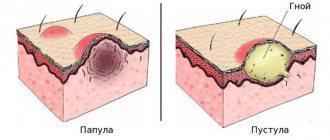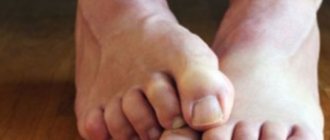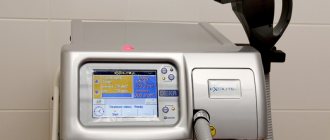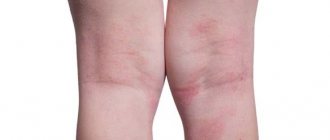What is psoriasis?
Psoriasis is an autoimmune disease that causes skin cells to grow too quickly, which accumulate and form inflamed red patches. Symptoms of psoriasis may vary depending on its type, stage, and cause. General signs of psoriasis:
- inflamed areas of skin;
- whitish-silver scales or plaques on red spots;
- soreness and burning of the skin;
- dry, cracked skin (may itch and bleed);
- stiff and swollen joints;
- thickened, ribbed nails.
Psoriasis in children usually first affects the scalp and nails, and then spreads to the elbows, knees and torso. With nail psoriasis in a child, depending on the type of psoriasis, thick nails without pits or with small ridges may be observed, as well as yellowing of the nails or their separation from the bed.
If you notice the first signs of psoriasis, you should consult a doctor. A dermatologist deals with the diagnosis and treatment of psoriasis in adults. If reddened spots on the skin or silvery scales appear in children, you should consult a pediatrician.
Treatment of psoriasis
Therapy depends on the form of the disease, the person’s age, the presence of joint lesions, and previously used techniques. Severe forms often require treatment procedures in a hospital setting.
In each case, possible risks and potential benefits are assessed, especially when it comes to toxic drugs and hormonal drugs. Local treatment is most often used: moisturize the skin, soften it, relieve inflammation. Source: A.R. Umerova, I.P. Dorfman, V.V. Dumchenko, L.P. Makukhina Modern approaches to the treatment of psoriasis in children and adolescents // Russian Medical Journal, 2015, No. 19, p. 1156
In severe cases, systemic therapy may be prescribed. This is necessary when the disease significantly reduces the child’s quality of life. The consent of the child and parents must be obtained for such therapy, because it can lead to a number of side effects. Courses of treatment are usually short, each stage is carefully monitored by a doctor.
After 15 years and/or with extensive lesions, PUVA therapy is performed. The child uses a special drug containing psoralen externally or orally. After about 3 hours, his entire body or individual areas are irradiated with long-wave UV for several minutes. After several sessions every other day, formations on the skin decrease or disappear, peeling and itching are eliminated.
If other methods are ineffective, immunosuppressants are prescribed. However, they increase the risk of malignant tumors, so they are used rarely and under the strictest medical supervision.
Vitamins are prescribed together with any course of treatment: B12, ascorbic acid, A, B15, D2, pyridoxine. Only the doctor determines the dosage!
If the disease occurs in conjunction with a skin infection, antibiotics are prescribed.
Any treatment is usually long-term and is carried out to ensure that the disease is controlled and does not reduce the standard of living. Psoriasis cannot be completely eliminated.
What does psoriasis look like?
With psoriasis, red spots appear on light skin and brown or purple spots on dark skin. At the initial stage of scalp psoriasis, the spots resemble dandruff (due to white scales). Forms of psoriasis:
- mild form of psoriasis (less than three percent of the body is affected, rashes are localized on the scalp or extremities);
- moderate form of psoriasis (the rash covers three to ten percent of the body, affecting the scalp, arms, legs and torso);
- severe form of psoriasis (more than ten percent of the body is affected, rashes appear on the palms, soles of the feet, and face).
Treatment for psoriasis is selected by a dermatologist depending on the form and type of psoriasis, symptoms and location of the rash. If treatment is incorrect or untimely, large areas of lesions appear on the skin.
Hyperkeratosis
The cause of dry skin on the elbows is hyperkeratosis: thickening of the stratum corneum of the skin and disruption of the keratinization process. It may be accompanied by increased skin pattern, pigmentation, and peeling. Irina Skorogudaeva notes that hyperkeratosis can occur as a result of mechanical stress on the skin, for example, frequent pressure on the elbows when sitting at a table.
“Skin is the first barrier that protects us from the external environment. If we somehow influence it, damage it, this is compensated: the regeneration process starts. As a result, local changes in the skin occur: it thickens, becomes drier, and an emphasized skin pattern appears. For example, the skin begins to thicken in the area where the shoes rub. The same goes for treating heels with a pumice stone or file: the more you remove the stratum corneum, the more it grows,” says the dermatologist.
Where can psoriasis occur?
The localization of psoriasis spots depends on its type. Types of psoriasis:
- plaque (vulgar) psoriasis. Plaque psoriasis causes dry, raised patches of skin covered with silvery scales. Psoriasis appears on the elbows, knees, lower back and scalp;
- erythrodermic psoriasis. The skin looks burned, chills appear, and the temperature rises;
- guttate psoriasis. Small scaly flesh-colored spots, similar to drops of water, form on the arms, legs, and torso;
- pustular psoriasis. With pustular psoriasis, white blisters filled with pus and large inflamed areas of skin form on the skin. Localized in small areas of the skin, affecting the legs or arms;
- exudative psoriasis. Spots covered with yellow crusts appear on the skin;
- inverse psoriasis. Smooth red spots appear on the skin. The rash occurs in folds of skin (armpits, buttocks, genitals).
In nail psoriasis, skin accumulates under the nails, causing them to lift and form indentations (“nail pits”). The skin under the nail plate becomes white, yellow or brown. Nails become rough, crumble, and quickly break.
Dermatologists also distinguish palmoplantar psoriasis. The skin with psoriasis of the palms and feet is dry and prone to cracks.
Eyelid psoriasis causes redness, flaking, and crusting around the eyelids. Other symptoms of psoriasis on the eyelids:
- the formation of scales that peel off and stick to the eyelashes;
- pain when moving the eyes;
- irritation of the skin of the eyelids, accompanied by pain and itching.
The edges of the eyelids may turn up or down depending on the location of the spots, which leads to friction between the eyelashes and the eyeball. Possible consequences of eyelid psoriasis include uveitis (inflammation of the eyes) and vision loss.
Psoriasis can appear on the eyebrows, behind and around the ears, and in the ear canal. Sometimes psoriasis affects the mouth, causing redness and burning of the lips, gums, tongue and cheeks. Oral psoriasis may cause difficulty chewing and swallowing food.
Manifestations of psoriasis depend on its type, symptoms and stage. Psoriasis can be seen in the photo.
1/3 psoriatic plaques on the elbows 2/3 psoriasis on the heels 3/3 manifestations of psoriasis on the knees
Reasons for the development of psoriasis
Psoriasis is caused by a malfunction of the immune system, in which white blood cells mistakenly begin to attack skin cells. Due to the action of leukocytes, the process of producing new skin cells is reduced from a month to several days. Cells formed ahead of time are pushed by the body to the surface of the skin, where they accumulate and transform into spots or plaques.
Genetic predisposition (a family history of psoriasis) or triggers (environmental factors that increase the risk of psoriasis) can lead to a malfunction in the immune system. Factors that provoke the development of psoriasis:
- infections (tonsillitis, herpes, lichen);
- skin trauma (sunburn, insect bite, scratches, cuts);
- smoking or alcohol abuse;
- uncontrolled use of medications;
- regular stressful situations (lead to the development of stress psoriasis);
- weather (dry and cold conditions);
- abrupt discontinuation of systemic or oral corticosteroids.
These factors can lead to the development of psoriasis in people predisposed to it, or cause an exacerbation. Exacerbation of psoriasis can be avoided by identifying and eliminating the factors that contribute to it.
Causes of psoriasis in children
Research continues all over the world to identify the causes of
this disease.
However, they have not yet been reliably established. The main theory is genetic predisposition
.
Scientists name the following as provoking factors:
- skin injury;
- lithium-containing medications;
- infectious diseases;
- metabolic disorders;
- dysfunction of the endocrine system;
- stress;
- smoking and drinking alcohol (applies to adults and adolescents);
- weak immunity.
Normally, skin cells mature in 30 days, but with this disease – in 4-5. As a result, papules are formed. The same abnormalities are found in apparently healthy tissues, and not just in areas of rashes.
Exacerbation of psoriasis
Psoriasis on the face, extremities and head is characterized by periods of exacerbation (symptoms appear intensely) and remission (the rash decreases in size, pain goes away). Periods of remission last from one month to a year. Stages of psoriasis:
- progressive stage (beginning of psoriasis). Small nodular rashes appear on the skin, which are accompanied by itching. Areas of redness increase, forming plaques;
- stationary stage. New nodules (papules) do not appear, inflammation subsides after the formation of scales or crusts on the plaques;
- regressive stage. Plaques decrease, itching and flaking disappear.
A dermatologist will help relieve an exacerbation of psoriasis, who will identify triggers and prescribe treatment. Following your doctor's recommendations will help reduce periods of exacerbations and increase periods of remission.
Psoriasis on elbows
array ( 'ID' => '9549', '~ID' => '9549', 'NAME' => 'Psoriasis on elbows', '~NAME' => 'Psoriasis on elbows', 'IBLOCK_ID' => ' 43', '~IBLOCK_ID' => '43', 'IBLOCK_SECTION_ID' => '1195', '~IBLOCK_SECTION_ID' => '1195', 'DETAIL_TEXT' => '
Psoriasis is a chronic non-infectious skin disease. One type of psoriasis is psoriasis on the elbows. Most often this type of disease affects people of both sexes over 45 years of age. In children, psoriasis on the elbows practically does not occur. Symptoms of psoriasis on the elbows are round or oval spots (plaques) of a reddish color, which gradually increase in size and merge with each other. At the initial stage of the disease, there are few spots and they are located chaotically, but if treatment is not started immediately, the rashes will occupy a large area of the skin. Gradually, the plaques become covered with grayish-silver scales, which, when scraped off, reveal a smooth thermal film. If it is removed, slight bleeding (blood dew) may occur. Sometimes there are no scales on the plaques, and the contours are outlined by a bright border. The spread of the rash is usually accompanied by severe itching and burning. The causes of psoriasis on the elbows have not yet been precisely determined. According to several theories, the most likely causes are: heredity, decreased immunity, mechanical damage to the skin, stress conditions, disturbances in the endocrine system, and disturbances in lipid metabolism in the body. How to get rid of psoriasis on the elbows? Psoriasis on the elbows, although treatable, is not completely curable. Comprehensive treatment should be aimed at eliminating the external symptoms of psoriasis and include:
- local therapy - ointments, creams;
- physiotherapy;
- special diet;
- taking vitamins.
How to treat psoriasis on the elbows?
If the form of psoriasis on the elbows is mild, then hydrating agents will be enough to soften the scales and reduce flaking. If the form of the disease is more severe, corticosteroids must be used.
Remedies for psoriasis on the elbows are mainly used externally. The doctor selects ointments for psoriasis on the elbows individually. These can be ointments containing vitamin D, Prednisolone, Hydrocortisone. An ointment containing activated zinc gives very good results.
Treatment with medications involves taking antihistamines and sedatives. Medicine for psoriasis on the elbows helps better if it is used in conjunction with physiotherapeutic procedures.
Treatment of psoriasis on the elbows at home involves the use of baths with a decoction of herbs (for example, chamomile, sage, string); compresses based on grated garlic; grease, tar.
', '~DETAIL_TEXT' => ' Psoriasis is a chronic disease of the skin of a non-infectious nature.
One type of psoriasis is psoriasis on the elbows. Most often this type of disease affects people of both sexes over 45 years of age. In children, psoriasis on the elbows practically does not occur.
Symptoms of psoriasis on the elbows are round or oval spots (plaques) of a reddish color, which gradually increase in size and merge with each other. At the initial stage of the disease, there are few spots and they are located chaotically, but if treatment is not started immediately, the rashes will occupy a large area of the skin. Gradually, the plaques become covered with grayish-silver scales, which, when scraped off, reveal a smooth thermal film. If it is removed, slight bleeding (blood dew) may occur. Sometimes there are no scales on the plaques, and the contours are outlined by a bright border. The spread of the rash is usually accompanied by severe itching and burning.
The causes of psoriasis on the elbows have not yet been precisely established. According to several theories, the most likely causes are: heredity, decreased immunity, mechanical damage to the skin, stress conditions, disturbances in the endocrine system, and disturbances in lipid metabolism in the body.
How to get rid of psoriasis on the elbows?
Psoriasis on the elbows, although treatable, is not completely curable. Comprehensive treatment should be aimed at eliminating the external symptoms of psoriasis and include:
- local therapy - ointments, creams;
- physiotherapy;
- special diet;
- taking vitamins.
How to treat psoriasis on the elbows?
If the form of psoriasis on the elbows is mild, then hydrating agents will be enough to soften the scales and reduce flaking. If the form of the disease is more severe, corticosteroids must be used.
Remedies for psoriasis on the elbows are mainly used externally. The doctor selects ointments for psoriasis on the elbows individually. These can be ointments containing vitamin D, Prednisolone, Hydrocortisone. An ointment containing activated zinc gives very good results.
Treatment with medications involves taking antihistamines and sedatives. Medicine for psoriasis on the elbows helps better if it is used in conjunction with physiotherapeutic procedures.
Treatment of psoriasis on the elbows at home involves the use of baths with a decoction of herbs (for example, chamomile, sage, string); compresses based on grated garlic; grease, tar.
', 'DETAIL_TEXT_TYPE' => 'html', '~DETAIL_TEXT_TYPE' => 'html', 'PREVIEW_TEXT' => 'Psoriasis is a chronic disease of the skin of a non-infectious nature. One type of psoriasis is psoriasis on the elbows. Most often this type of disease affects people of both sexes over 45 years of age. In children, psoriasis on the elbows practically does not occur.', '~PREVIEW_TEXT' => 'Psoriasis is a chronic disease of the skin of a non-infectious nature. One type of psoriasis is psoriasis on the elbows. Most often this type of disease affects people of both sexes over 45 years of age. In children, psoriasis on the elbows practically does not occur.', 'PREVIEW_TEXT_TYPE' => 'text', '~PREVIEW_TEXT_TYPE' => 'text', 'DETAIL_PICTURE' => NULL, '~DETAIL_PICTURE' => NULL, 'TIMESTAMP_X' => '03.10.2018 21:27', '~TIMESTAMP_X' => '03.10.2018 21:27', 'ACTIVE_FROM' => NULL, '~ACTIVE_FROM' => NULL, 'LIST_PAGE_URL' => '/forpatients/school/ info/', '~LIST_PAGE_URL' => '/forpatients/school/info/', 'DETAIL_PAGE_URL' => '/forpatients/school/info/psoriaz/psoriaz-na-loktyakh/', '~DETAIL_PAGE_URL' => ' /forpatients/school/info/psoriaz/psoriaz-na-loktyakh/', 'LANG_DIR' => '/', '~LANG_DIR' => '/', 'CODE' => 'psoriaz-na-loktyakh', ' ~CODE' => 'psoriaz-na-loktyakh', 'EXTERNAL_ID' => '9549', '~EXTERNAL_ID' => '9549', 'IBLOCK_TYPE_ID' => 'SERVICE', '~IBLOCK_TYPE_ID' => 'SERVICE' , 'IBLOCK_CODE' => ", '~IBLOCK_CODE' => ", 'IBLOCK_EXTERNAL_ID' => ", '~IBLOCK_EXTERNAL_ID' => ", 'LID' => 's1', '~LID' => 's1', 'NAV_RESULT' => false, 'DISPLAY_ACTIVE_FROM' => ", 'IPROPERTY_VALUES' => array ( ), 'FIELDS' => array ( ), 'PROPERTIES' => array ( 'IMAGES' => array ( 'ID' = > '240', 'TIMESTAMP_X' => '2017-11-15 09:11:27', 'IBLOCK_ID' => '43', 'NAME' => 'Photo gallery', 'ACTIVE' => 'Y', 'SORT' => '500', 'CODE' => 'IMAGES', 'DEFAULT_VALUE' => ", 'PROPERTY_TYPE' => 'F', 'ROW_COUNT' => '1', 'COL_COUNT' => '30 ', 'LIST_TYPE' => 'L', 'MULTIPLE' => 'Y', 'XML_ID' => ", 'FILE_TYPE' => 'jpg, gif, bmp, png, jpeg', 'MULTIPLE_CNT' => ' 5', 'TMP_ID' => NULL, 'LINK_IBLOCK_ID' => '0', 'WITH_DESCRIPTION' => 'Y', 'SEARCHABLE' => 'N', 'FILTRABLE' => 'N', 'IS_REQUIRED' = > 'N', 'VERSION' => '1', 'USER_TYPE' => NULL, 'USER_TYPE_SETTINGS' => NULL, 'HINT' => ", 'PROPERTY_VALUE_ID' => false, 'VALUE' => false, ' DESCRIPTION' => false, 'VALUE_ENUM' => NULL, 'VALUE_XML_ID' => NULL, 'VALUE_SORT' => NULL, '~VALUE' => false, '~DESCRIPTION' => false, '~NAME' => ' Photo gallery', '~DEFAULT_VALUE' => "), 'BLOCK_EXP' => array ( 'ID' => '241', 'TIMESTAMP_X' => '2017-11-15 09:11:27', 'IBLOCK_ID' => '43', 'NAME' => 'Sharing experience', 'ACTIVE' => 'Y', 'SORT' => '500', 'CODE' => 'BLOCK_EXP', 'DEFAULT_VALUE' => array ( 'TYPE' => 'HTML', 'TEXT' => "), 'PROPERTY_TYPE' => 'S', 'ROW_COUNT' => '1', 'COL_COUNT' => '30', 'LIST_TYPE' => 'L', 'MULTIPLE' => 'N', 'XML_ID' => ", 'FILE_TYPE' => ", 'MULTIPLE_CNT' => '5', 'TMP_ID' => NULL, 'LINK_IBLOCK_ID' => '0 ', 'WITH_DESCRIPTION' => 'N', 'SEARCHABLE' => 'N', 'FILTRABLE' => 'N', 'IS_REQUIRED' => 'N', 'VERSION' => '1', 'USER_TYPE' => 'HTML', 'USER_TYPE_SETTINGS' => array ( 'height' => 400, ), 'HINT' => ", 'PROPERTY_VALUE_ID' => NULL, 'VALUE' => ", 'DESCRIPTION' => ", 'VALUE_ENUM' => NULL, 'VALUE_XML_ID' => NULL, 'VALUE_SORT' => NULL, '~VALUE' => ", '~DESCRIPTION' => ", '~NAME' => 'Sharing experience', '~ DEFAULT_VALUE' => array ( 'TYPE' => 'HTML', 'TEXT' => "), ), 'BLOCK_VIDEO' => array ( 'ID' => '242', 'TIMESTAMP_X' => '2017- 11-15 10:20:07', 'IBLOCK_ID' => '43', 'NAME' => 'Youtube Video', 'ACTIVE' => 'Y', 'SORT' => '500', 'CODE' => 'BLOCK_VIDEO', 'DEFAULT_VALUE' => array ( 'TEXT' => ", 'TYPE' => 'HTML', ), 'PROPERTY_TYPE' => 'S', 'ROW_COUNT' => '1', ' COL_COUNT' => '50', 'LIST_TYPE' => 'L', 'MULTIPLE' => 'N', 'XML_ID' => ", 'FILE_TYPE' => ", 'MULTIPLE_CNT' => '5', ' TMP_ID' => NULL, 'LINK_IBLOCK_ID' => '0', 'WITH_DESCRIPTION' => 'N', 'SEARCHABLE' => 'N', 'FILTRABLE' => 'N', 'IS_REQUIRED' => 'N' , 'VERSION' => '1', 'USER_TYPE' => 'HTML', 'USER_TYPE_SETTINGS' => array ( 'height' => 200, ), 'HINT' => ", 'PROPERTY_VALUE_ID' => NULL, ' VALUE' => ", 'DESCRIPTION' => ", 'VALUE_ENUM' => NULL, 'VALUE_XML_ID' => NULL, 'VALUE_SORT' => NULL, '~VALUE' => ", '~DESCRIPTION' => ", '~NAME' => 'Youtube Video', '~DEFAULT_VALUE' => array ( 'TEXT' => ", 'TYPE' => 'HTML', ), 'BLOCK_VIDEO_DESC' => array ( 'ID' = > '243', 'TIMESTAMP_X' => '2017-11-15 09:11:27', 'IBLOCK_ID' => '43', 'NAME' => 'Video description', 'ACTIVE' => 'Y' , 'SORT' => '500', 'CODE' => 'BLOCK_VIDEO_DESC', 'DEFAULT_VALUE' => array ( 'TYPE' => 'HTML', 'TEXT' => "), 'PROPERTY_TYPE' => ' S', 'ROW_COUNT' => '1', 'COL_COUNT' => '30', 'LIST_TYPE' => 'L', 'MULTIPLE' => 'N', 'XML_ID' => ", 'FILE_TYPE' = > ", 'MULTIPLE_CNT' => '5', 'TMP_ID' => NULL, 'LINK_IBLOCK_ID' => '0', 'WITH_DESCRIPTION' => 'N', 'SEARCHABLE' => 'N', 'FILTRABLE' = > 'N', 'IS_REQUIRED' => 'N', 'VERSION' => '1', 'USER_TYPE' => 'HTML', 'USER_TYPE_SETTINGS' => array ( 'height' => 400, ), 'HINT ' => ", 'PROPERTY_VALUE_ID' => NULL, 'VALUE' => ", 'DESCRIPTION' => ", 'VALUE_ENUM' => NULL, 'VALUE_XML_ID' => NULL, 'VALUE_SORT' => NULL, '~VALUE ' => ", '~DESCRIPTION' => ", '~NAME' => 'Video description', '~DEFAULT_VALUE' => array ( 'TYPE' => 'HTML', 'TEXT' => "), ), 'BLOCK_TEXT_BOTTOM' => array ( 'ID' => '244', 'TIMESTAMP_X' => '2017-11-15 09:11:27', 'IBLOCK_ID' => '43', 'NAME' => 'Text block at the bottom of the page', 'ACTIVE' => 'Y', 'SORT' => '500', 'CODE' => 'BLOCK_TEXT_BOTTOM', 'DEFAULT_VALUE' => array ( 'TYPE' => 'HTML', 'TEXT' => "), 'PROPERTY_TYPE' => 'S', 'ROW_COUNT' => '1', 'COL_COUNT' => '30', 'LIST_TYPE' => 'L', 'MULTIPLE' => 'N', 'XML_ID' => ", 'FILE_TYPE' => ", 'MULTIPLE_CNT' => '5', 'TMP_ID' => NULL, 'LINK_IBLOCK_ID' => '0', 'WITH_DESCRIPTION' => 'N ', 'SEARCHABLE' => 'N', 'FILTRABLE' => 'N', 'IS_REQUIRED' => 'N', 'VERSION' => '1', 'USER_TYPE' => 'HTML', 'USER_TYPE_SETTINGS' => array ( 'height' => 400, ), 'HINT' => ", 'PROPERTY_VALUE_ID' => NULL, 'VALUE' => ", 'DESCRIPTION' => ", 'VALUE_ENUM' => NULL, 'VALUE_XML_ID ' => NULL, 'VALUE_SORT' => NULL, '~VALUE' => ", '~DESCRIPTION' => ", '~NAME' => 'Text block at the bottom of the page', '~DEFAULT_VALUE' => array ( ' TYPE' => 'HTML', 'TEXT' => "), ), 'AMP' => array ( 'ID' => '305', 'TIMESTAMP_X' => '2021-03-01 22:23: 44', 'IBLOCK_ID' => '43', 'NAME' => 'AMP', 'ACTIVE' => 'Y', 'SORT' => '500', 'CODE' => 'AMP', 'DEFAULT_VALUE ' => ", 'PROPERTY_TYPE' => 'S', 'ROW_COUNT' => '1', 'COL_COUNT' => '30', 'LIST_TYPE' => 'L', 'MULTIPLE' => 'N', 'XML_ID' => ", 'FILE_TYPE' => ", 'MULTIPLE_CNT' => '5', 'TMP_ID' => NULL, 'LINK_IBLOCK_ID' => '0', 'WITH_DESCRIPTION' => 'N', 'SEARCHABLE ' => 'N', 'FILTRABLE' => 'N', 'IS_REQUIRED' => 'N', 'VERSION' => '1', 'USER_TYPE' => NULL, 'USER_TYPE_SETTINGS' => NULL, 'HINT ' => ", 'PROPERTY_VALUE_ID' => NULL, 'VALUE' => ", 'DESCRIPTION' => ", 'VALUE_ENUM' => NULL, 'VALUE_XML_ID' => NULL, 'VALUE_SORT' => NULL, '~VALUE ' => ", '~DESCRIPTION' => ", '~NAME' => 'AMP', '~DEFAULT_VALUE' => ", ), ), 'DISPLAY_PROPERTIES' => array ( ), 'IBLOCK' => array ( 'ID' => '43', '~ID' => '43', 'TIMESTAMP_X' => '02/13/2022 01:10', '~TIMESTAMP_X' => '02/13/2022 01:10', ' IBLOCK_TYPE_ID' => 'SERVICE', '~IBLOCK_TYPE_ID' => 'SERVICE', 'LID' => 's1', '~LID' => 's1', 'CODE' => ", '~CODE' => ", 'API_CODE' => NULL, '~API_CODE' => NULL, 'NAME' => 'Information for patients', '~NAME' => 'Information for patients', 'ACTIVE' => 'Y', ' ~ACTIVE' => 'Y', 'SORT' => '500', '~SORT' => '500', 'LIST_PAGE_URL' => '/forpatients/school/info/', '~LIST_PAGE_URL' => ' /forpatients/school/info/', 'DETAIL_PAGE_URL' => '#SITE_DIR#/forpatients/school/info/#SECTION_CODE_PATH#/#ELEMENT_CODE#/', '~DETAIL_PAGE_URL' => '#SITE_DIR#/forpatients/school/ info/#SECTION_CODE_PATH#/#ELEMENT_CODE#/', 'SECTION_PAGE_URL' => '#SITE_DIR#/forpatients/school/info/#SECTION_CODE_PATH#/', '~SECTION_PAGE_URL' => '#SITE_DIR#/forpatients/school/info /#SECTION_CODE_PATH#/', 'PICTURE' => NULL, '~PICTURE' => NULL, 'DESCRIPTION' => ", '~DESCRIPTION' => ", 'DESCRIPTION_TYPE' => 'text', '~DESCRIPTION_TYPE' => 'text', 'RSS_TTL' => '24', '~RSS_TTL' => '24', 'RSS_ACTIVE' => 'Y', '~RSS_ACTIVE' => 'Y', 'RSS_FILE_ACTIVE' => ' N', '~RSS_FILE_ACTIVE' => 'N', 'RSS_FILE_LIMIT' => NULL, '~RSS_FILE_LIMIT' => NULL, 'RSS_FILE_DAYS' => NULL, '~RSS_FILE_DAYS' => NULL, 'RSS_YANDEX_ACTIVE' => 'N ', '~RSS_YANDEX_ACTIVE' => 'N', 'XML_ID' => ", '~XML_ID' => ", 'TMP_ID' => '5c2d3bb63f567ed46286eaaccecaea60', '~TMP_ID' => '5c2d3bb63f567ed46286eaaccecaea60', 'INDEX_ELEMENT' = > 'Y', '~INDEX_ELEMENT' => 'Y', 'INDEX_SECTION' => 'Y', '~INDEX_SECTION' => 'Y', 'WORKFLOW' => 'N', '~WORKFLOW' => ' N', 'BIZPROC' => 'N', '~BIZPROC' => 'N', 'SECTION_CHOOSER' => 'L', '~SECTION_CHOOSER' => 'L', 'LIST_MODE' => ", '~ LIST_MODE' => ", 'RIGHTS_MODE' => 'S', '~RIGHTS_MODE' => 'S', 'SECTION_PROPERTY' => 'N', '~SECTION_PROPERTY' => 'N', 'PROPERTY_INDEX' => ' N', '~PROPERTY_INDEX' => 'N', 'VERSION' => '1', '~VERSION' => '1', 'LAST_CONV_ELEMENT' => '0', '~LAST_CONV_ELEMENT' => '0' , 'SOCNET_GROUP_ID' => NULL, '~SOCNET_GROUP_ID' => NULL, 'EDIT_FILE_BEFORE' => ", '~EDIT_FILE_BEFORE' => ", 'EDIT_FILE_AFTER' => ", '~EDIT_FILE_AFTER' => ", 'SECTIONS_NAME' = > 'Sections', '~SECTIONS_NAME' => 'Sections', 'SECTION_NAME' => 'Section', '~SECTION_NAME' => 'Section', 'ELEMENTS_NAME' => 'Elements', '~ELEMENTS_NAME' => ' Elements', 'ELEMENT_NAME' => 'Element', '~ELEMENT_NAME' => 'Element', 'CANONICAL_PAGE_URL' => ", '~CANONICAL_PAGE_URL' => ", 'EXTERNAL_ID' => ", '~EXTERNAL_ID' => ", 'LANG_DIR' => '/', '~LANG_DIR' => '/', 'SERVER_NAME' => 'logoderm.ru', '~SERVER_NAME' => 'logoderm.ru', ), 'SECTION' = > array ( 'PATH' => array ( 0 => array ( 'ID' => '1195', '~ID' => '1195', 'CODE' => 'psoriaz', '~CODE' => ' psoriaz', 'XML_ID' => ", '~XML_ID' => ", 'EXTERNAL_ID' => ", '~EXTERNAL_ID' => ", 'IBLOCK_ID' => '43', '~IBLOCK_ID' => '43 ', 'IBLOCK_SECTION_ID' => NULL, '~IBLOCK_SECTION_ID' => NULL, 'SORT' => '500', '~SORT' => '500', 'NAME' => 'Psoriasis', '~NAME' = > 'Psoriasis', 'ACTIVE' => 'Y', '~ACTIVE' => 'Y', 'DEPTH_LEVEL' => '1', '~DEPTH_LEVEL' => '1', 'SECTION_PAGE_URL' => '/ forpatients/school/info/psoriaz/', '~SECTION_PAGE_URL' => '/forpatients/school/info/psoriaz/', 'IBLOCK_TYPE_ID' => 'SERVICE', '~IBLOCK_TYPE_ID' => 'SERVICE', 'IBLOCK_CODE' => ", '~IBLOCK_CODE' => ", 'IBLOCK_EXTERNAL_ID' => ", '~IBLOCK_EXTERNAL_ID' => ", 'GLOBAL_ACTIVE' => 'Y', '~GLOBAL_ACTIVE' => 'Y', 'IPROPERTY_VALUES' = > array ( ), ), ), 'SECTION_URL' => '/forpatients/school/info/psoriaz/', 'META_TAGS' => array ( 'TITLE' => 'Psoriasis on the elbows', 'ELEMENT_CHAIN' = > 'Psoriasis on the elbows', 'BROWSER_TITLE' => ", 'KEYWORDS' => ", 'DESCRIPTION' => ", ), ) Psoriasis is a chronic disease of the skin of a non-infectious nature.
One type of psoriasis is psoriasis on the elbows. Most often this type of disease affects people of both sexes over 45 years of age. In children, psoriasis on the elbows practically does not occur.
Symptoms of psoriasis on the elbows are round or oval spots (plaques) of a reddish color, which gradually increase in size and merge with each other. At the initial stage of the disease, there are few spots and they are located chaotically, but if treatment is not started immediately, the rashes will occupy a large area of the skin. Gradually, the plaques become covered with grayish-silver scales, which, when scraped off, reveal a smooth thermal film. If it is removed, slight bleeding (blood dew) may occur. Sometimes there are no scales on the plaques, and the contours are outlined by a bright border. The spread of the rash is usually accompanied by severe itching and burning.
The causes of psoriasis on the elbows have not yet been precisely established. According to several theories, the most likely causes are: heredity, decreased immunity, mechanical damage to the skin, stress conditions, disturbances in the endocrine system, and disturbances in lipid metabolism in the body.
How to get rid of psoriasis on the elbows?
Psoriasis on the elbows, although treatable, is not completely curable. Comprehensive treatment should be aimed at eliminating the external symptoms of psoriasis and include:
- local therapy - ointments, creams;
- physiotherapy;
- special diet;
- taking vitamins.
How to treat psoriasis on the elbows?
If the form of psoriasis on the elbows is mild, then hydrating agents will be enough to soften the scales and reduce flaking. If the form of the disease is more severe, corticosteroids must be used.
Remedies for psoriasis on the elbows are mainly used externally. The doctor selects ointments for psoriasis on the elbows individually. These can be ointments containing vitamin D, Prednisolone, Hydrocortisone. An ointment containing activated zinc gives very good results.
Treatment with medications involves taking antihistamines and sedatives. Medicine for psoriasis on the elbows helps better if it is used in conjunction with physiotherapeutic procedures.
Treatment of psoriasis on the elbows at home involves the use of baths with a decoction of herbs (for example, chamomile, sage, string); compresses based on grated garlic; grease, tar.
Material prepared by: Ravodin Roman Anatolchevich, Doctor of Medical Sciences, Associate Professor
Go to consultation
return to Psoriasis section
How to treat psoriasis?
Before starting treatment for psoriasis, the dermatologist collects an anamnesis (asks about symptoms, when they appeared, and whether there is a family history of psoriasis) and conducts a visual examination of the rash. After making a diagnosis, the doctor selects a comprehensive treatment for psoriasis. Treatment for psoriasis includes:
- ointments, shampoos, creams and gels based on extracts of algae and Dead Sea minerals;
- phototherapy (by exposing rash-affected skin to ultraviolet rays, the growth of skin cells is reduced, leading to normalization of the condition).
For psoriasis, a dermatologist recommends taking vitamins. To produce healthy skin cells and reduce inflammation and symptoms, your doctor will prescribe vitamins A, D, E, K, B, and C.
Diet for psoriasis
For psoriasis, a dermatologist recommends dietary changes. Foods that reduce inflammation:
- fatty fish (tuna, salmon);
- flax and pumpkin seeds;
- nuts (walnuts, almonds);
- cabbage, spinach.
Following a diet for psoriasis helps reduce symptoms and prevent the development of complications (high blood pressure, diabetes, heart disease). If you have psoriasis on your legs, arms, or face, you should limit your alcohol intake.
Your diet should also include consumption of foods that contain fatty acids (sardines, salmon, shrimp, flax seeds). It is recommended to minimize the consumption of foods that contain saturated fats (fatty meats, confectionery) and simple carbohydrates (dairy products, grapes, baked goods).
Prevention of psoriasis
Preventive measures will help prevent the development and progression of psoriasis on the arms, legs, and head. Prevention of psoriasis includes:
- dietary changes (abstinence from alcohol, simple carbohydrates and saturated fats, consumption of foods containing fatty acids);
- protecting your head and body from the sun (using sunscreen and a hat);
- to give up smoking;
- reducing the risk of skin injury (use of insect repellent sprays, gloves, long sleeves);
- moisturizing the skin (dry skin is prone to damage).
To reduce the likelihood of a psoriasis flare-up, extreme temperatures should be avoided. Exposure to temperatures that are too cold or too hot can cause your skin to dry out or become damaged. Reducing stressful situations to a minimum will help prevent the appearance of psoriasis due to nervousness.
Clinical researches
The conducted clinical study proves the high efficiency, safety and tolerability of products for daily skin care of children with mild and moderate forms of atopic dermatitis and during remission, accompanied by a decrease in the quality of life of patients. As a result of therapy, a decrease in the activity of the inflammatory process, a decrease in dryness, itching and flaking was noted.
The products are recommended by the St. Petersburg branch of the Union of Pediatricians of Russia.
It has been clinically proven that La-Cri cream for dry skin moisturizes and nourishes the skin, relieves itching and irritation, and also soothes and restores the skin.
Sources:
- Chapman M. Shane, Habiff Thomas P., Zug Catherine A., Dinoulos James G. H., Campbell James L., Dermatology. Handbook of differential diagnosis, MEDpress-inform, 2014.
- Sukolin Gennady Ivanovich, Illustrated clinical dermatology. Brief alphabetical reference book, Lux Print publishing house, 2010.
- Sukolin Gennady Ivanovich, Clinical dermatology. A short guide to the diagnosis and treatment of dermatoses, Notabene, 2017.
How to distinguish psoriasis from dermatitis?
Scalp psoriasis (seborrheic psoriasis) is similar to seborrheic dermatitis. Dermatitis can be distinguished from scalp psoriasis with the help of a dermatologist. Symptoms of seborrheic dermatitis:
- redness of the skin, on which greasy white or yellow scales form (when pressed, sebum - sebum - can be released);
- dandruff (flakes of skin) that accumulate near the hair shaft.
You can distinguish psoriasis from dermatitis by the location of the rash. Unlike seborrheic dermatitis, psoriasis does not only form on the head, but also spreads beyond the hairline and appears on other parts of the body (limbs, lower back, nails). With psoriasis, the areas of the skin affected by the rash are sore and itchy, and with dermatitis, you may feel a slight itching of the scalp.
Endocrine disorders
The cause of excessive dry skin, including on the elbows, can be a hormonal imbalance. In turn, it can be caused by endocrine diseases, taking hormonal drugs, age-related changes or congenital characteristics.
The sebaceous glands located on the skin are responsible for the protective function. “The production of sebum occurs under the influence of sex steroid hormones, primarily androgens and estrogens. Accordingly, if you produce less of these hormones, your skin remains dry. The cause may be endocrine diseases. For example, pronounced changes in the skin occur with diabetes mellitus. Hormonal levels can also change the use of hormonal medications. There are also individual congenital characteristics: weak sensitivity of receptors to the actions of hormones, resulting in low sebum production, resulting in drier skin. In addition, with age, sebum is produced in smaller quantities, again due to a decrease in the production of sex hormones,” the doctor notes.
Popular questions
1. Is psoriasis transmitted?
Psoriasis is not contagious. Contact (communication, kissing, sexual intercourse) with a person with psoriasis, touching the affected areas of the skin will not lead to the appearance of a rash, since we are talking about an autoimmune and not an infectious disease.
2. How to wash your hair with psoriasis?
For psoriasis, you can wash your hair with a shampoo based on Dead Sea minerals and algae extract. Independent selection of shampoos and the use of folk remedies (chamomile tincture, celandine, aloe vera, apple cider vinegar) will be ineffective and may lead to worsening symptoms. If a skin rash is detected, you should contact a dermatologist, who, after examining the redness and making a diagnosis, will select the treatment option that suits you.
3. How to distinguish nail psoriasis from fungus?
You can distinguish nail psoriasis from fungus using symptoms. With psoriasis, nails thicken, crumble, break quickly, and the skin underneath becomes yellow, white, or brown. The nails may develop indentations (pits), ridges, or holes.
Fungus causes gray, brown, or green spots on the nails that darken and increase in size over several weeks. Fungal infection of the nails does not lead to the formation of pits, but can cause the nails to become thin or thick.
4. What should you not eat if you have psoriasis?
If you have psoriasis, you should not eat foods that increase inflammation (dairy products, red meat, fatty foods, refined sugar, citrus fruits, tomatoes, potatoes). You should avoid eating eggs, liver, soybeans, and energy drinks. These products contain choline and taurine, which can cause an exacerbation of psoriasis.
5. What can psoriasis be confused with?
Psoriasis can be confused with eczema, ringworm, lichen planus or lichen planus. To diagnose psoriasis from other dermatological diseases, please consult a dermatologist for additional medical history, visual examination and diagnostic investigations.
1
0
0
Article rating:
5 out of 5 based on 2 ratings
Author: Vitsinskaya Elena Igorevna
Dermatologist-trichologist. Highest category. Work experience 28 years.











